Turneffe Flats
Registered
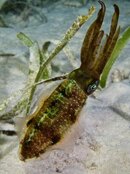
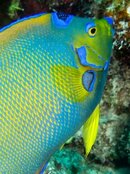
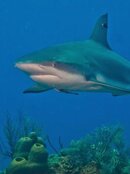
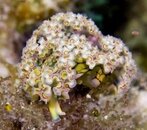
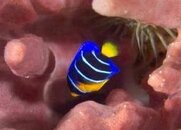
PHOTOS BY DENIS BAYLOR
DIVE REPORT - 10 to 15 August, 2014
Air Temperatures – Mid 80’s
Water Temperature – 84F
Weather for the week was kind to the divers, offering about 10 knots of northeasterly breeze and surface conditions with gentle swells of no more than four feet. Skies were mostly sunny with some passing clouds and showers. Both Divemaster Denroy and Dive Instructor Anne-Marie guided for the week, with Carlton (AKA Capt) handling our 36-foot dive boat Miss Turneffe, designed for medium-sized groups of 5 to 10 divers.
Black Pearl, as well as North and South Creekozene, were the chosen dive sites of the day all delivering a clear 80 feet of visibility. Some of the eye-catching sightings included a tiny Pipefish which lay on the sand and waved its tail and body mimicking a piece of seaweed waving gently in the surge. A Yellow Stingray was spotted hiding in the sand with only its eyes and pumping gills visible. A Giant Barrel Sponge filled with Neon Gobies anxious to nibble on extended hands, brought the expression “a barrel full of gobies”, to mind. Two tiny juvenile Peacock Flounders were barely visible through their movement as they were perfectly camouflaged on the sand bottom. An inch-long juvenile Nassau Grouper flexed its predatory muscles from its hiding place in the hole of a small tube sponge, stalking unwary minute shrimp nearby. A large frond of soft coral growing in a sand bed turned out to be cover for a host of transparent Gorgonian Shrimp that only became visible as they darted from branch to branch. A healthy-sized Black Grouper swam by in its full display of black and white batik-like pattern. The white jagged lines of this interesting design radiated away from its eyes, creating a startlingly beautiful effect.
For the second day, we visited the Terrace, Mandy’s Dandy, and Chasbow’s Corner, all with 70 feet of visibility. There were numerous quantities of small, brilliantly coloured purple and orange-yellow Fairy Basslets everywhere, in addition to their less spectacular Black Cap Basslets cousins. Magnifying glasses offered close up views of Arrow Blennies, Wire Coral Shrimp, and Neck Crabs covered with reddish-brown sponge for a disguise. A Hawksbill Turtle, and a Spotted Eagle Ray, both made an appearance. Blue Bogas shot down the wall in a tight school, followed by enterprising Bar Jacks. A squadron of three Mackrel swam by at a steady pace in mid-water, as schools of blue Creole Wrasse streamed through coral heads on the top of the wall.
The best weather conditions were available for our weekly visit to the Blue Hole on Tuesday, so we headed out early to be the first ones to arrive. Both a deep and shallower version of this dive was covered as we had varying dive experience abilities with our group. Divers who went to the full 130 feet, had a full view of the Caribbean Reef Sharks when three showed up. Visibility was 60 feet both shallow and deep. Divers doing the shallower plan did a maximum depth of 70 feet, and found they could just make out one of the giant stalactites that hung out at the top of the overhang below them. They too saw the sharks down in the deep. Four large resident Midnight Parrots cruised the top of the ledge at 40 feet munching on algae growth both from the bottom and what grew on dead coral. They were quite comfortable allowing divers to venture close, and a view of their moss-covered mouths revealed a likeness to large mustaches. At this close proximity, one could see the detail of the serrated edge on their large, formidable beaks. Our second dive at Half Moon Caye Wall gave divers 70 feet of visibility, and a fair amount of sightings. A Caribbean Reef Shark swam back and forth along the wall just below divers for half of the dive. Nassau Groupers were spotted facing off in a scuffle on the side of the wall, and a Great Barracuda shot down to them as if to find out what the row was about. A Green Turtle tootled around on the top of the wall for several minutes, going up to the surface for air, and returning again for more foraging. A small school of Rainbow Runners raced past, followed by shimmering, darting Mackrel Scad. Ballyhoos swam just below the surface above divers, as two Permit dived down from a shallow position to skirt the top of the reef wall. A Spotted Eagle Ray swung by, as two Great Barracudas chased each other with a burst of incredible speed. When divers pulled off over to the sand bed next to the wall, there seemed to be large Southern Sting Rays everywhere, whether sitting partially hidden in the sand, or digging around for hidden treats. After an extended lunch time break at the beautiful and tranquil isle of Half Moon Caye, we chose the Aquarium as our third dive location, and had 60 feet of visibility there. This dive site is encrusted with knots of life. Here, sponges, as well as hard and soft corals all hang tightly packed off of older coral growth everywhere. Divers get an eyeful of colours and textures on this beautiful wall that has promontories thick with Deep Water Gorgonian Sea Fan growth. A number of hefty Black Groupers cruised the area, both off the wall, and between stands of Gorgonians. Three Caribbean Reef Sharks were seen in various sizes. The first was about three feet long, followed by a tiny one that couldn’t have been longer than 18 inches. The last was a bit bigger at four feet, but was still smaller than those seen previously that day at Blue Hole and Half Moon Caye Wall.
The Elbow was the choice for Wednesday’s dives, and Myrtle’s Turtle right next door was visited for the second dive. There was a northbound current that divers swam against for the first dive. Visibility was excellent at 80 feet for each dive, and the water seemed particularly clear, showing off the intricate detail of the spectacular spur and groove formations along the wall’s edge at both of these sites. An unusual sight of at least a thirty-strong school of Mackerel swam by on two occasions. A unit of ten large Permit swam over the reef swimming past the divers and along with the current. A huge gathering of Dog Snappers were spotted just at the visibility line, far off of the wall. A Hawksbill Turtle fed contentedly on a large Loggerhead Sponge on the bottom. Smaller schools of Rainbow Runners, Cubera Snappers, and Atlantic Spade Fish also showed up. Divers got a bonus at the end of the Elbow dive, when Bottlenose Dophins decided to join them with their squeaks and clicks, darting up and down in the water column. What a great treat for the day! The Night Dive offered a full spectrum of reef dweller sightings. Lots of Caribbean Spiny Lobsters were quite active crawling over the reef heads. Beaded Sea Cucumbers were out, as well as a Sea Hare, and Lettuce Leaf Slug. Even Octopus and Squid were seen. Large flotillas of Sargassum Seaweed started drifting in, and juvenile fish were seen hiding below its canopy near the surface, exposed by the beam of divers’ lights.
Choices of Elkin’s Bay, Molly’s Folly, and Tunnels & Barrels to the northwest were made for Thursdays dive sites, all offering 70 feet of great visibility. Three Spotted Eagle Rays swam together up the wall and passed by at close range surprising divers, who were focusing on small subjects with their cameras. Divers took closer looks at Pederson Shrimp, Squat Anemone Shrimp, and the easy-to-find Coral Banded Shrimp with its long white antenna giving away its hiding place in tight crevices. In addition, a not-often-seen Cryptic Teardrop Crab was spotted in a tube sponge.
For the last day of diving, divers decided to only do two of the three dives offered due to departure flight times the following day. Pine Ridge with its big bay-shaped sand bed nestled between coral walls, and Amberhead with a dizzying collection of sponges offered great views with 70 feet of visibility. A Spotted Eagle Ray, and a Hawksbill Turtle showed up for a farewell viewing before divers had to surface for the last safety stop.




